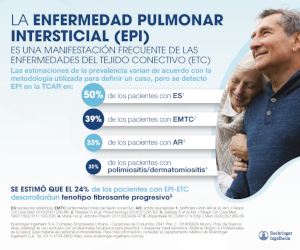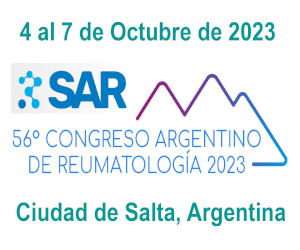Impacto de la presencia de depresión y ansiedad en pacientes con artritis psoriásica
Resumen
Introducción: un tercio de los pacientes con artritis psoriásica (APs) sufre ansiedad y/o depresión, lo que podría impactar negativamente en la actividad de la enfermedad.Los objetivos de este estudio fueron: evaluar la prevalencia de depresión y ansiedad en pacientes con APs, estudiar su asociación con diferentes factores sociodemográficos y clínicos, y determinar el efecto sobre los diferentes componentes de los índices compuestos de la actividad de la APs. Materiales y métodos: se incluyeron pacientes con APs que cumplían criterios de la Classi cation criteria of psoriatic arthritis (CASPAR). La depresión se de nió según el Patient Health Questionnaire-9 (PHQ-9) y la ansiedad según el cuestionario General Anxiety Disorder-7 (GAD-7). Se realizó regresión logística múltiple para identi car variables asociadas a ansiedad y depresión. Resultados: se incluyeron 100 pacientes con APs, de los cuales el 26% y el 59% presentaron depresión mayor y ansiedad respectivamente. Los pacientes con depresión mayor tuvieron mayor actividad de la enfermedad, dolor, fatiga, ansiedad, y menor educación formal y peor calidad de vida. Aquellos con ansiedad manifestaron mayor actividad de la enfermedad, dolor y fatiga, y peor calidad de vida y capacidad funcional. La alta actividad de la enfermedad y la menor educación formal se asociaron independientemente con depresión mayor. Conclusiones: la presencia de depresión mayor y ansiedad se asoció con mayor actividad de la enfermedad en pacientes con APs.Citas
I. Alinaghi F, Calov M, Kristensen LE, Gladman DD, Coates LC, Jullien D, et al. Prevalence of psoriatic arthritis in patients with psoriasis: A systematic review and meta-analysis of observational and clinical studies. J Am Acad Dermatology. 2019;80(1):251-65.
II. Ritchlin CT, Colbert RA GD. Psoriatic Arthritis. N Engl J Med. 2017;376(10):957-70.
III. Maldonado Ficco H, Citera G, Maldonado Cocco JA. Prevalence of psoriatic arthritis in psoriasis patients according to newer classification criteria. Clin Rheumatol. 2014;33(10):1489-93.
IV. Ogdie A, Schwartzman S, Eder L, Maharaj A, Zisman D, Raychaudhuri S, et al. Comprehensive treatment of psoriatic arthritis: Managing comorbidities and extraarticular manifestations. J Rheumatol. 2014;41(11):2315-22.
V. Zaffarana C, Gallino Yanzi J, Cerda OL, Landi M, Schneeberger E, Citera G. Prevalence of Obesity in Patients with Psoriatic Arthritis and Its Impact on the Severity of the Disease. Arthritis Rheumatol 2016;68(Suppl 10):A2768.
VI. Moltó A, Etcheto A, van der Heijde D, Landewé R, van den Bosch F, Bautista Molano W, et al. Prevalence of comorbidities and evaluation of their screening in spondyloarthritis: Results of the international cross-sectional ASAS-COMOSPA study. Ann Rheum Dis. 2016;75(6):1016-23.
VII. Kamalaraj N, El-Haddad C, Hay P, Pile K. Systematic review of depression and anxiety in psoriatic arthritis. Int J Rheum Dis. 2019;22(6):967-73.
VIII. Kramer N, Cosgrove V, Dunlap K, Subramaniapillai M, McIntyre R, Suppes T. A clinical model for identifying an inflammatory phenotype in mood disorders. J Psychiatr Res. 2019;113(1):148-58.
IX. Husni M, Merola J, Davin S. The psychosocial burden of psoriatic arthritis. Semin Arthritis Rheum. 2017;47(3):351-60.
X. Felger J, Lotrich F. Inflammatory cytokines in depression: Neurobiological mechanisms and therapeutic implications. Neuroscience. 2013;246(13):199-229.
XII. McEvoy A, Bresnihan B, Fitzgerald O, Murphy E. Corticotropin-releasing hormone signaling in synovial tissue from patients with early inflammatory arthritis is mediated by the type 1α corticotropin-releasing hormone receptor. Arthritis Rheum. 2001;44(8):1761-7.
XII. Arborelius L, Owens M, Plotsky P, Nemeroff C. The role of corticotropin-releasing factor in depression and anxiety disorders. J Endocrinol. 1999;160(1):1-12.
XIII. McDonough E, Ayearst R, Eder L, Chandran V, Rosen C, Thavaneswaran A, et al. Depression and anxiety in psoriatic disease: Prevalence and associated factors. J Rheumatol. 2014;41(5):887-96.
XIV. Michelsen B, Kristianslund E, Sexton O, Hammer H, Fagerli K, Lie E, et al. Do depression and anxiety reduce the likelihood of remission in rheumatoid arthritis and psoriatic arthritis? Data from the prospective multicentre NOR-DMARD study. Ann Rheum Dis. 2017;76(11):1906-10.
XV. Boyden SD, Hossain IN, Wohlfahrt A, Lee YC. Non-inflammatory Causes of Pain in Patients with Rheumatoid Arthritis. Curr Rheumatol Rep. 2016;18(6):30.
XVI. Meeus M, Vervisch S, De Clerck L, Moorkens G, Hans G, Nijs J. Central sensitization in patients with rheumatoid arthritis: A systematic literature review. Semin Arthritis Rheum. 2012;41(4):556-67.
XVII. Isnardi C, Schneeberger E, Capelusnik D, Bazzarelli M, Barloco L. Rev Argent Reum. 2007;45(2):24.
XVIII. Beck AT, Ward CH, Mendelson M ME. Inventory for Measuring Depression. Arch Gen Psychiatry. 1961;4(6):561-71.
XIX. Roadolff L. The CES-D scale: A self-report depression scale for research in the general population. Appl Psychol Meas. 1977;1(1):385.
XX. Kroenke K, Spitzer R, Williams J. The PHQ-9: validity of a brief depression severity measure. J Gen Intern Med. 2001;16(9):606-13.
XXI. Rossom R, Coleman K, Ahmedani B, Beck A, Johnson E, Oliver M, et al. Suicidal ideation reported on the PHQ9 and risk of suicidal behavior across age groups. J Affect Disord. 2017;215(1):7-84.
XXII. Zöger S, Svedlund J, Holgers K. The Hospital Anxiety and Depression Scale (HAD) as a screening instrument in tinnitus evaluation. Int J Audiol. 2004;43(8):458-64.
XXIII. Spielberger C, Goursch R LR. The Design of Gradings with Small Interconnection Numbers for Random Hunt Selectors. IEEE Trans Commun. 1975;23(7):714-21.
XIV. Spitzer RL, Kroenke K, Williams JW, Löwe B. A brief measure for assessing generalized anxiety disorder: The gad-7. Arch Intern Med. 2006;166(10):1092-7.
XV. Taylor W, Gladman D, Helliwell P, Marchesoni A, Mease P, Mielants H. Classification criteria for psoriatic arthritis: Development of new criteria from a large international study. Arthritis Rheum. 2006;54(8):2665-73.
XVI. Charlson M, Charlson R, Peterson J, Marinopoulos S, Briggs W, Hollenberg J. The Charlson comorbidity index is adapted to predict costs of chronic disease in primary care patients. J Clin Epidemiol. 2008;61(12):1234-40.
XVII. Charlson M, Pompeim P, Ales KL, MacKenzie CR. a New Method of Classifying Prognostic in Longitudinal Studies: Development and validation. J Chronic Dis. 1987;40(5):373-83.
XVIII. Wolfe F, Clauw D, Fitzcharles M, Goldenberg D, Katz R, Mease P, et al. The American College of Rheumatology preliminary diagnostic criteria for fibromyalgia and measurement of symptom severity. Arthritis Care Res. 2010;62(5):600-10.
XIX. Heuft-Dorenbosch L, Spoorenberg A, van Tubergen A, Landewé R, van der Tempel H, Mielants H, et al. Assessment of enthesitis in ankylosing spondylitis. Ann Rheum Dis. 2003;62(2):127-32.
XXX. Wallace A. The exposure treatment of burns. Lancet. 1951;3(4):501-4.
XXXI. Esteve J , Batlle E RA. Spanish version of the Health Assessment Questionnaire: reliability, validity and transcultural equivalency. Grupo para la Adaptación del HAQ a la Población Española. J Rheumatol. 1993;20(12):2116-22.
XXXII. Citera G, Arriola M, Maldonado Cocco JA, Rosemffet M, Sánchez M, Goñi M, et al. Validation and crosscultural adaptation of an Argentine Spanish version of the Health Assessment Questionnaire disability index. J Clin Rheumatol. 2004;10(3):110-5.
XXXIII. McKenna S, Doward L, Whalley D, Tennant A, Emery P, Veale D. Development of the PsAQoL: A quality of life instrument specific to psoriatic arthritis. Ann Rheum Dis. 2004;63(2):162-9.
XXXIV. Finlay A, Khan G. Dermatology Life Quality Index (DLQI)—a simple practical measure for routine clinical use. Clin Exp Dermatol. 1994;19(3):210-6.
XXXV. Schoels M, Aletaha D, Funovits J, Kavanaugh A, Baker D, Smolen J. Application of the DAREA/DAPSA score for assessment of disease activity in psoriatic arthritis. Ann Rheum Dis. 2010;69(8):1441-7.
XXXVI. Smolen J, Schoels M, Aletaha D. Disease activity and response assessment in psoriatic arthritis using the Disease Activity index for PSoriatic Arthritis (DAPSA). A brief review. Clin Exp Rheumatol. 2015;33(2):48-50.
XXXVII. Coronel Ale AL, Schneeberger EE, Cerda OL, Zaffarana C F, MN, Landi M et al. Disease Activity in Psoriatic Arthritis-ESR Index Maybe a Valid Tool to Evaluate Disease Activity in Patients with Psoriatic Arthritis When CRP Is Not Available. Arthritis Rheumatol. 2017;69(10):2554.
XXXVIII. Prevoo ML, van’ t Hof MA, Kuper HH, van Leeuven MA, van de Putte LB, van Riel PL. Modified disease activity scores that include twenty-eight-joint counts. Development and validation in a prospective longitudinal study of patients with rheumatoid arthritis. Arthritis Rheum. 1995;38(1):44-8.
XXXIX. van Der Heijde DM, van’t Hof MA, van Riel PL, Theunisse LA, Lubberts EW, van Leeuwen MA, et al. Judging disease activity in clinical practice in rheumatoid arthritis: First step in the development of a disease activity score. Ann Rheum Dis. 1990;49(11):916-20.
XL. Coates L, Helliwell P. Validation of minimal disease activity criteria for psoriatic arthritis using interventional trial data. Arthritis Care Res. 2010;62(7):965-9.
XLI. Allen F, Harold A, Michael B, Andreasen N, Barlow D, Campbell M, et al. DSM-IV. Manual diagnóstico y estadístico de los trastornos mentales. Rev Mex Neurocien. 2009;10(1):34-43.
XLII. Howells L , Chisholm A, Cotteril S, Chinoy H WR. The impact of disease severity, illness beliefs and coping strategies on outcomes in psoriatic arthritis. Arthritis Care Res. 2018;70(1):295-302.
XLIII. Zusman E, Howren A, Park JYE, Dutz J, De Vera M. Epidemiology of depression and anxiety in patients with psoriatic arthritis: A systematic review and meta-analysis. Semin Arthritis Rheum. 2020;50(6):1481-8.
XLIV. Kotsis K, Voulgari P, Tsifetaki N, MacHado M, Carvalho A, Creed F, et al. Anxiety and depressive symptoms and illness perceptions in psoriatic arthritis and associations with physical health-related quality of life. Arthritis Care Res. 2012;64(10):1593-601.
XLV. Wu JJ, Penfold RB, Primatesta P, Fox TK, Stewart C, Reddy SP, et al. The risk of depression, suicidal ideation and suicide attempt in patients with psoriasis, psoriatic arthritis or ankylosing spondylitis. J Eur Acad Dermatol Venereol. 2017;31(7):1168-75.
XLVI. Bavière W, Deprez X, Houvenagel E, Philippe P, Deken V, Flipo RM et al. Association between comorbidities and quality of life in psoriatic arthritis: results from a multicentric cross-sectional study (PSAQUAL study). J Rheumatol. 2020;47(3):369-76.
XLVII. Duvetorp A, Østergaard M, Skov L, Seifert O, Tveit KS, Danielsen K, et al. Quality of life and contact with healthcare systems among patients with psoriasis and psoriatic arthritis: results from the NORdic PAtient survey of Psoriasis and Psoriatic arthritis (NORPAPP). Arch Dermatol Res. 2019;311(5):351-60.
XLVIII. Michelsen B, Kristianslund E, Hammer H, Fagerli K, Lie E, Wierød A, et al. Discordance between tender and swollen joint count as well as patient’s and evaluator’s global assessment may reduce likelihood of remission in patients with rheumatoid arthritis and psoriatic arthritis: Data from the prospective multicentre NOR-DMARD stu. Ann Rheum Dis. 2017;76(4):708-11.
XLIX. Uhlig T, Moe R, Kvien T. The Burden of Disease in Rheumatoid Arthritis. Pharmacoeconomics. 2014;32(9):841-51.
L. Smolen J, Braun J, Dougados M, FitzGerald O, Helliwell P, Kavanaugh A, et al. Treating spondyloarthritis, including ankylosing spondylitis and psoriatic arthritis, to target: Recommendations of an international task force. Ann Rheum Dis. 2014;73(1):6-16.
Derechos de autor 2022 A nombre de los autores. Derechos de reproducción: Sociedad Argentina de Reumatología

Esta obra está bajo licencia internacional Creative Commons Reconocimiento-NoComercial-SinObrasDerivadas 4.0.
















